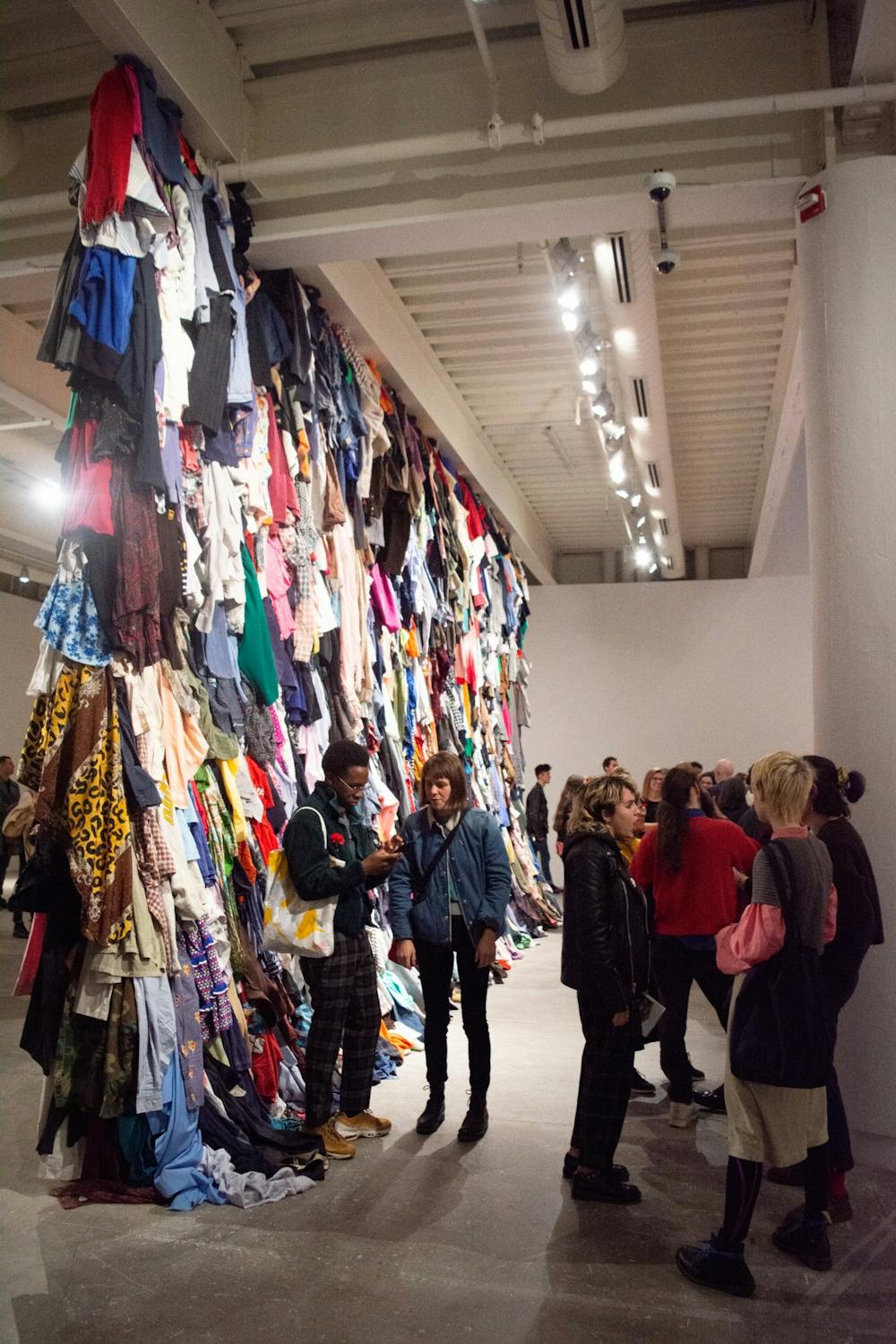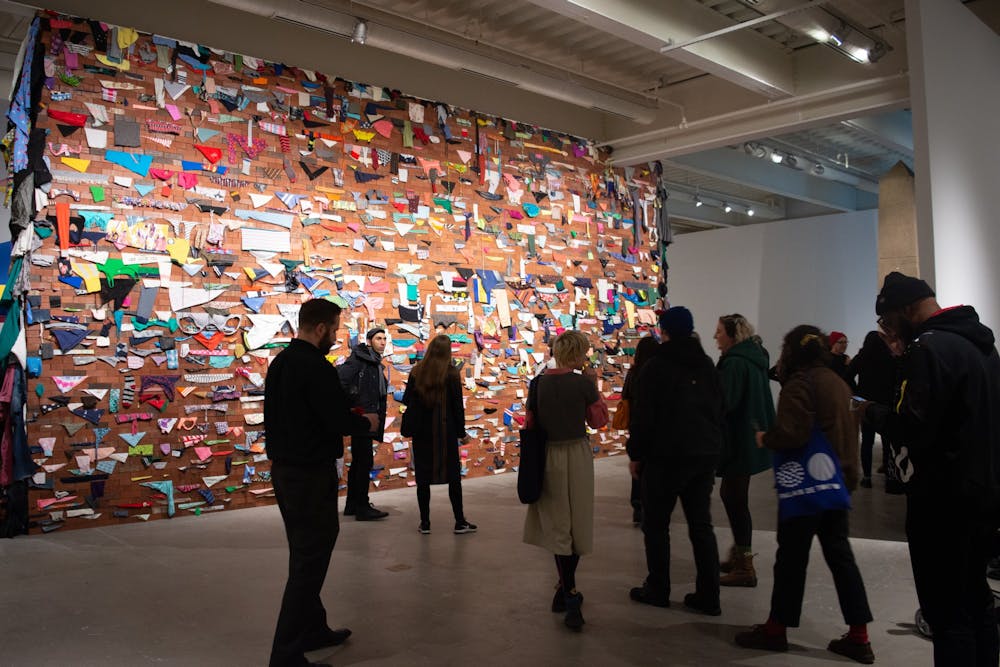When I first stepped into the Institute of Contemporary Art, I was handed a fresh, bright red carnation and a pin topped by a pearl bead, which I chose to attach to the top left side of my shirt.
This carnation, or May 12, 1985, is one of six works in Karyn Olivier’s Everything That’s Alive Moves, part of the ICA’s three Winter 2020 exhibitions. In 1907, carnations came to represent Mother’s Day. According to the placard, Anna Jarvis had campaigned for this day of recognition “to make men and women realize their individual responsibility to right the wrongs of motherhood and childhood, not only in the home, but also in the industrial world,” since 1905. With this in mind, the carnation turned personal and was chosen in honor of her mother.
Meanwhile, in Philadelphia, Mother’s Day holds additional significance. MOVE, a black liberation movement founded in West Philly in 1972, was subject to frequent police violence due to their anarchro–primitavism, or the political belief that modern capitalism has obliterated social progress. On May 13, 1985, a police helicopter bombed the MOVE compound, killing 11 members, including 5 children, and fires from the bomb destroyed 65 neighboring houses. The police had issued eviction and arrest warrants to MOVE the previous day—Mother’s Day.
Wearing the red carnation while learning this felt surreal. White carnations meant that your mother had passed away, while red carnations were worn if your mother was alive. Olivier’s choice to give red carnations instead of white felt purposeful, for it represents a celebration of life and motherhood while also recognizing those who had died on Mother’s Day. An item of commemoration in the midst of destruction.
Everything That’s Alive Moves takes a critical look at monuments and how they interact with people, political histories, and communities. The exhibit focuses on the raw, emotional power of monuments and their inherently political construction, noting how they sometimes operate in opposite ways. While monuments are often viewed as grand and imposing, Olivier’s work also explores how public spaces and commemorations can impact individuals and communities intimately.
The gallery collection spans the first floor of the ICA, which is the perfect size to house four large sculptures and the space needed to sit with their implications. You have the space to circle each piece and examine their details. The exhibit constructs a space where grandeur is expected, but proximity is necessary.
The collection is made up of three existing works and three new ones developed between 2018 and 2019, when Olivier spent a year studying public spaces and ruins in Rome. Despite the movement and reshaping of old temples, walls, and monuments, the city’s history remains evident, giving Olivier inspiration for the current exhibit.
One of the works Olivier began during this time is Moving the Obelisk. Designed to emulate the process museums and galleries go through with actual artifacts, this work features the dismantling of a cardboard obelisk at the American Academy in Rome and the subsequent reattaching of said object in the ICA itself. Originating from Egypt, obelisks have often been presented as gifts, sometimes through theft, to institutions all around the globe. This artistic practice represents the conquest inherent in the colonial era.

The obelisk itself is presented in its full form, much like how one would see it in a museum collection, but the full story is captured by the accompanying video. In 12 minutes, Olivier dismantles and transports the obelisk. Olivier then cuts it into sections with harsh scissors, only to later reassemble it with plastic zip ties. While it seems almost absurd to watch this process happen to dirt and cardboard, it seems heartbreaking to think of important monuments dissected so clinically and casually. In the voiceover, Olivier probes at this practice and asks, “What has been left behind? What legacy is lost?”
Two existing exhibits Olivier added to this collection are Car Cover and Export Shoes and Fortify. Car Cover and Export Shoes features shoes piled up under a Mercedes car hood. The shoes are only held in place by the hood, and the tension in the work is palatable. Fortify is a wall that rises to the ceiling of the gallery. Within each layer of brick and mortar, clothes and undergarments are layered in, and from one side it looks like a cascade of garments.
The clothes and shoes that make up each of these works are varied, representing a variety of colors and textures that range from animal prints and glitter to the sturdy neutrals of work pants. Who wore these clothes? What did their lives look like? How do their stories play into the creation of this monument? The deliberate ambiguity of the exhibit creates endless questions, and perhaps the point is that they remain unanswered.
Both sculptures are somewhat overwhelming at first glance. Despite being made up of ordinary items, each structure represents something larger than life. These remnants of a past life evoke the feeling of sacrifice and make the viewer question the costs these monuments to history require from our society.
Olivier’s exhibit is titled Everything That’s Alive Moves. While moving through the gallery, I wondered what exactly that meant. All of the works move in some way. Each constructed, transported, and reflected the tensions beneath each surface, tying together the mix of stories that make up each moment. Every monument has existed in the past, the present, and the future, moving through time and space. While monuments tend to immortalize one story, Olivier invites us to celebrate the different experiences that make up history.
After all, as Olivier herself has said, “I heard someone say that a monument reads like the end of the sentence. But no, no, a monument should be the beginning, where you start to ask the questions.”

